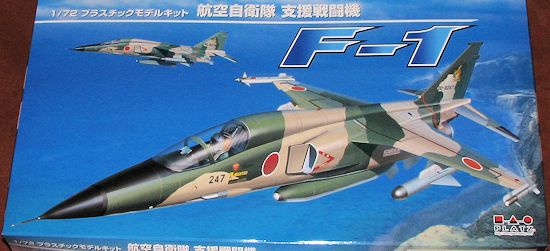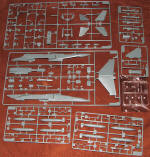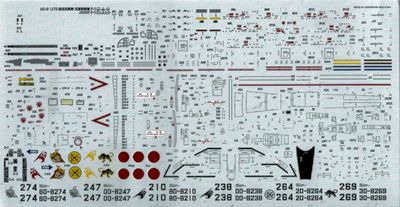
Platz 1/72 Mitsubishi F-1
| KIT #: | AC-9 |
| PRICE: | 2400 yen SRP |
| DECALS: | Six options |
| REVIEWER: | Scott Van Aken |
| NOTES: | New tool kit |

| HISTORY |
In the mid 1960s, the Japan Air Self-Defense Force (JASDF) commenced studies into an advanced jet trainer which could also be modified to serve in the ground attack and anti-shipping roles. After considering license production of the T-38 Talon and SEPECAT Jaguar, Japan decided to develop its own trainer, the supersonic Mitsubishi T-2, this first flying on 20 July 1971. Cost over-runs in the T-2 program lead to the proposed single seat attack version almost being abandoned, but the cancellation of the Kawasaki P-XL, the planned replacement for Japan's Kawasaki P-2J maritime patrol aircraft freed-up funds, while making it important to keep Japan's aviation industry employed, and contracts were awarded for the development of the attack version as the FS-T2kai in 1973.
The new aircraft was a minimum change derivative of the T-2, with the rear cockpit being converted to an avionics bay by removing the rear seat, and replacing the canopy with a simple unglazed access hatch. Two additional hardpoints were fitted under the wing to allow carriage of a heavier weapon load, and the avionics were improved, with a new J/AWG-12 radar set, similar to that fitted in British Royal Air Force F-4M Phantom fighter jets. This set provides ranging information. Aside from the avionics changes, deletion of the rear seat, and new one-piece canopy, the only other major change from the T-2 was the strengthening of the airframe to enable it to carry a larger weapons load than the T-2. The F-1 is fitted with an internally mounted 20 mm JM61A1 Vulcan cannon with 750 rounds of ammunition. The aircraft also has seven external hardpoints for the carriage of a wide variety of stores. The fuselage hardpoint and inboard pair of underwing hardpoints are "wet", which means they can be used to carry external fuel tanks to increase the aircraft's range. The primary weapon of the F-1 is the ASM-1 and the newer ASM-2 long-range anti-ship missile. This weapon is roughly in the class of the American AGM-84 Harpoon or French AM.39 Exocet. Other weapons carried include the all-aspect short-range heat-seeking AIM-9 Sidewinder air-to-air missile for air-to-air combat. This weapon is carried on the wingtip rails usually, but it can also be carried on the outboard underwing hardpoints for the F-1's secondary air defense role. Other air-to-ground weapons carried include rocket pods (JLAU-3/A) of 70 mm (2.75 in) size as well as bombs of 227 kg (500 lb) and 340 kg (750 lb) in size (Mk82 and M117 respectively). In addition, the Mk-82 and M117 bombs can be fitted with infrared guidance kits, turning them into precision-guided weapons that home in on heat radiation emitted from seaborne targets such as ships or other ground-based targets. When fitted with this kit, the bomb becomes known as GCS-1.
The F-1 has slowly been replaced over the years by the newer F-2 (Japan/U.S. developed, based on F-16C/D), as well as upgraded F-4EJ "Kai" Phantom IIs. Units currently using the F-1 are scheduled to change over to the new F-2 over the next several years. One unit has already traded in its F-1s for F-4EJ Kais. The last six active F-1s, based at Tsuiki in Fukuoka Prefecture, were retired on 9 March 2006, having reached the 4,000 hour limit of their airframes. A total of 77 aircraft were built. During its lifetime, it was operated by four squadrons and in later years wore the two blues scheme now common on the F-2 and other aircraft that operate over the seas.
| THE KIT |
 I'm not sure who does the molds for Platz kits, but they seem to very much have things well in hand. This one has superbly engraved panel lines with indented fastener detail. I know some do not like it, but it looks great on this one. There are quite a few sprues, several of them dedicated to weapons and things under wings. The kit will obviously be boxed as a T-2, but such are the sprues that this one will only do the F-1.
I'm not sure who does the molds for Platz kits, but they seem to very much have things well in hand. This one has superbly engraved panel lines with indented fastener detail. I know some do not like it, but it looks great on this one. There are quite a few sprues, several of them dedicated to weapons and things under wings. The kit will obviously be boxed as a T-2, but such are the sprues that this one will only do the F-1.
The cockpit is very nicely done with a dual seat tub, of which only the front seat will be used. Instrument panel and side consoles have raised detailing and you have decals that you can place over them if you wish. The seat is a single piece and while nicely done, could stand a resin replacement. No harness detail, of course. The area that would be the rear canopy is a solid piece and to it you fit all the front canopy actuating gear.
Intakes are nice and deep and whle there is no blanking plate, one is not really needed. As is the case with every aircraft designed like this, there is a lower section to the fuselage that has to be fit in place. Down there are also dual speed brakes and there are a pair of stabilizing fins that will need the holes opened before installation. The leading edge slats on the one piece upper wing are separate and should be slightly drooped on the ground. The lower wing inserts will need to have pylon mounting holes opened.
Landing gear are relatively complex and Platz has pulled it off well. Though separate, the forward main gear doors are normally closed as is the main nose gear door. There are pylons for the seven weapons locations. Among the things that can be carried under wings are Sidewinders, fuel tanks, ASM-1 missiles, and CBLS-200 bomb rack.
 Instructions are very nicely done and provide Gunze as well as Model Master paint references. All the markings options are similar to the box art. Though the box art shows nice, crisp edges to the colors, when I looked at images on the web, the overspray was pretty big in many cases. As a note, the wing camo wraps around the leading edge. There are five options among the three squadrons that flew the plane. There are early and late markings for 3 and 8 squadron while just the single option for 6 squadron. The decal sheet is just incredible in terms of the markings it give. It includes all sorts of panels, stripes and a plethora of data markings. Probably take as long to apply all the decals as it does to build the kit! I have darkened the sheet image in hopes of showing the white sealant bits around the clear parts, but I don't think I was that successful.
Instructions are very nicely done and provide Gunze as well as Model Master paint references. All the markings options are similar to the box art. Though the box art shows nice, crisp edges to the colors, when I looked at images on the web, the overspray was pretty big in many cases. As a note, the wing camo wraps around the leading edge. There are five options among the three squadrons that flew the plane. There are early and late markings for 3 and 8 squadron while just the single option for 6 squadron. The decal sheet is just incredible in terms of the markings it give. It includes all sorts of panels, stripes and a plethora of data markings. Probably take as long to apply all the decals as it does to build the kit! I have darkened the sheet image in hopes of showing the white sealant bits around the clear parts, but I don't think I was that successful.
| CONCLUSIONS |
Those of us who have been around since God was a cherub, know that Hasegawa has covered both the T-2 and F-1 before in this scale, but those are old school raised panel line kits and have been severely trumped by this new one from Platz. I would imagine that this will be a bigger seller in Japan than the rest of the world, but if you like this neat jet, this is the kit you should seek.
| REFERENCES |
December 2013
Thanks to Platz Hobby for the preview kit. Get yours at your local shop or you can order yours direct from this link.
If you would like your product reviewed fairly and fairly quickly, please contactthe editor or see other details in the